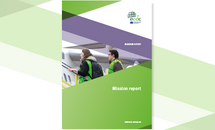Tuberculosis in the Netherlands
Report of the joint ECDC and WHO review of the tuberculosis prevention and care system in the Netherlands, 24–28 June 2019
Executive Summary
Rationale and purpose of the country visit
The Netherlands is a low tuberculosis (TB) burden country in western Europe which in the last two decades has achieved significant progress in reducing its TB notification rate from 9.8 per 100 000 in 1999 to 4.7 per 100 000 in 2018. Since 77% of all reported TB cases in the Netherlands are of foreign origin, current TB strategies focus mainly on active case finding by screening among certain population groups at risk for TB (including migrants and asylum seekers), contact investigation and management of latent TB infection (LTBI) and TB patients with active disease. Since 2004, favourable treatment outcomes for drug-susceptible TB have exceeded 85%, which has contributed to the overall decline in TB incidence and mortality. Over the past few years a low number of cases with drug-resistant TB have been registered (10–15 patients annually) and all have had access to therapy in accordance with the latest World Health Organization guidelines.
The Centre for Infectious Disease Control of the National Institute for Public Health and the Environment (RIVM), the KNCV Tuberculosis Foundation (KNCV) and the National Association of Municipal Health Services and Regional Medical Emergency Preparedness and Planning Offices (GGD GHOR Nederland) requested an external review of the TB prevention and care activities in the Netherlands. The European Centre for Disease Prevention and Control (ECDC) and the World Health Organization’s Regional Office for Europe (WHO) then jointly conducted a country visit to provide expert advice on sustaining the accessibility, quality, effectiveness and efficiency of TB prevention and care measures. A team of six experts visited the Netherlands between 24 and 28 June 2019 to perform the external review, in collaboration with national counterparts. The external review focused on LTBI screening among migrants and retention of knowledge and expertise on TB prevention and control in a country with declining TB incidence. The progress made on the recommendations from the 2013 international review was also assessed.
Technical reports, surveillance data, national guidelines and epidemiological data were reviewed in preparation for the country visit. During the visits to health authorities, health services and a TB hospital, the review team met healthcare personnel. Interviews were held with key informants representing public health authorities and professional organisations involved in the provision of TB services. The review team then suggested options to further strengthen TB prevention and care based on findings and the latest WHO and ECDC policy guidance on TB prevention and care.
Key findings
Screening of LTBI in migrants
- The Committee for Practical Tuberculosis Control has issued national guidelines for LTBI diagnosis, LTBI treatment, and LTBI/TB screening in persons infected with HIV. The Dutch Thoracic Society has developed a set of guidelines on LTBI/TB screening prior to immunosuppressive medication.
- Targeted diagnosis and treatment of LTBI among people at risk of TB is performed and monitored routinely in the Netherlands, along with active TB case finding.
- Since December 2015, screening and treatment for LTBI has been recommended for migrants under the age of 18 years. Other migrants are not targeted unless they have concomitant risk factors.
- There are some system barriers to accessing TB services, including LTBI screening and treatment, for certain population groups, particularly asylum seekers, undocumented migrants and other vulnerable populations (i.e. compulsory deductible payment).
- Several treatment regimens are recommended for LTBI treatment. Since 1993, municipal health services (GGDs) and hospitals can voluntarily report LTBI cases to an anonymised, nationwide, case-based register. The LTBI register is linked to the national TB register and enables the monitoring of treatment initiation, treatment completion and reasons for interrupting treatment among those with a positive LTBI test.
Human resources
- Healthcare professionals working in TB prevention and care at municipal health service (GGD) level have a well-established collaboration with the clinical sector and other GGDs.
- There is a good networking and linkage between the relevant institutions involved in TB prevention and care (RIVM, KNCV, GGDs, hospitals, sanatoria and the penitentiary system) and many of these organisations are involved in training and capacity building.
- The changes in TB epidemiology in the country (i.e. an overall decrease in TB case numbers) have an impact on the volume and the nature of TB activities.
- The number of trained TB physicians and nurses is decreasing and in some areas, the number of trained professionals is insufficient.
- Continuous education is required for re-registration as a TB public health physician and it is also necessary for other professionals working in TB prevention and care. Medical technical assistants do not have a mandatory system of registration. However, a TB refresher training day is organised on an annual basis.
Options
Screening of LTBI in migrants
- To consider extending the policy of systematic testing and treatment for LTBI to all migrants and asylum seekers from countries with a high TB burden who have entered Europe during the last five years or less.
- This policy change could be considered after a feasibility analysis, including the human resource and costeffectiveness aspects.
- To operationalise systematic LTBI testing and treatment of at-risk migrants and asylum seekers by: providing information on LTBI and LTBI treatment to all immigrants recommended for testing and treatment; assessing whether the GGDs could act as the primary entry point for systematic testing and treatment of LTBI in migrants; screening migrants for LTBI as soon as possible after their settlement in the Netherlands. General practitioners may facilitate linkage to LTBI screening for newly-arrived immigrants with residence permits as a result of family reunification.
- To continue offering a range of different LTBI treatment regimens so that each person can be treated with the most appropriate treatment. Shorter regimens should be prioritised.
- To continue the monitoring of the programmatic management for LTBI by using indicators already implemented (e.g. treatment acceptance among those eligible and LTBI treatment completion) and by introducing new indicators (e.g. number of people eligible for LTBI screening and number of people screened for LTBI) to allow for the monitoring of WHO-recommended indicators.
Human resources
- To establish an inclusive stakeholder platform for the development of a capacity building plan and to steer the implementation.
- To develop a flexible and adjustable competency framework for TB prevention and care activities for GGDs, taking into account the diversity in the different GGD areas.
- To give greater emphasis to TB-related topics in general infectious disease public health training for doctors, nurses and medical technical assistants.
- To ensure that adequate training, mentoring and supervision is provided when tasks are shifted to healthcare workers not previously involved in TB prevention and care activities.
- To consider developing international collaboration with high-TB burden countries or settings. TB professionals in the Netherlands would benefit from capacity building and training activities in settings with more TB patients than in the Netherlands, especially for diagnosis and treatment of TB. If necessary, relevant national and international stakeholders could also be involved, with the possible support of the KNCV, RIVM, ECDC and WHO.
Conclusions
The Netherlands is achieving significant progress towards eliminating TB and implementing the National TB Control Plan for 2016-–2020. With focus on implementing a combination of strategies for LTBI screening among migrants and management of active TB, the Netherlands National TB Programme is setting an example in achieving targets and milestones under the global End TB Strategy and the WHO Regional TB Action Plan for Europe, 2016–2020. Retaining knowledge and expertise among public health TB professionals on TB prevention and care should be one of the priorities of the Netherlands’ National TB Programme on its path towards TB elimination.
Download
Read more
Strategies and guidelines for tuberculosis
Recommendations and guidance on public health policy and strategy for tuberculosis.
Facts about tuberculosis
Tuberculosis (TB) is a serious infectious disease that can be fatal. It most commonly affects the lungs.
World Tuberculosis Day campaign
World Tuberculosis Day is marked on 24 March to raise awareness of tuberculosis on a global scale.
Public health guidance on tuberculosis control in vulnerable and hard-to-reach populations
This guidance provides support to those working towards strengthening tuberculosis prevention and control among vulnerable populations.








